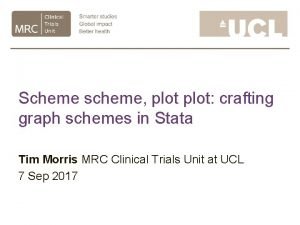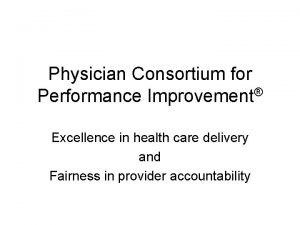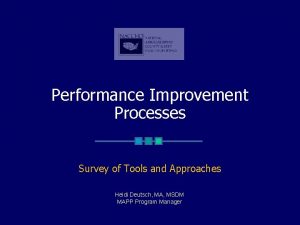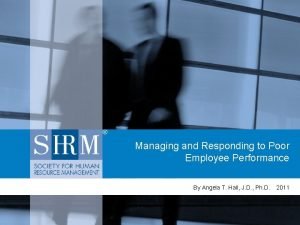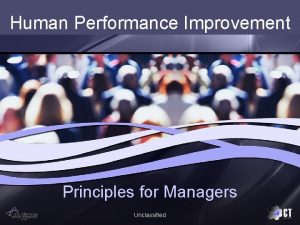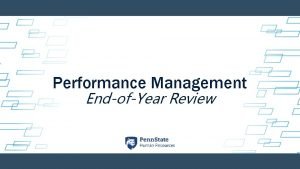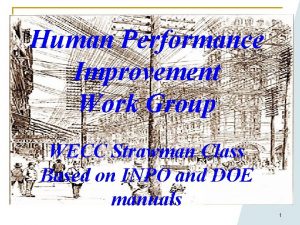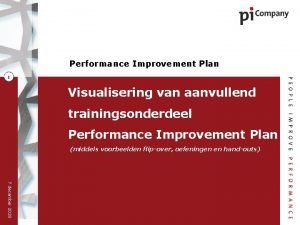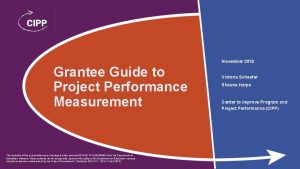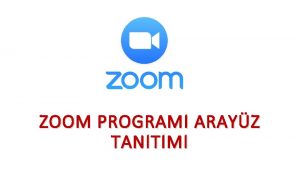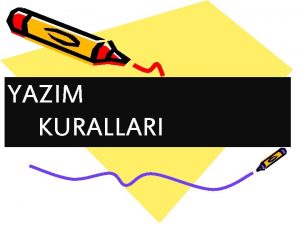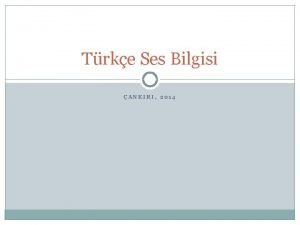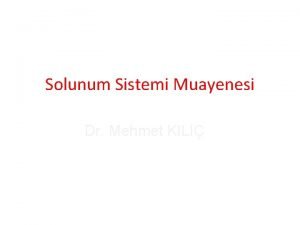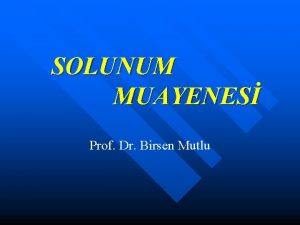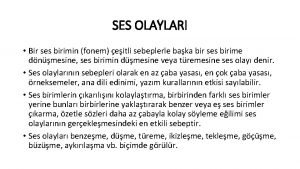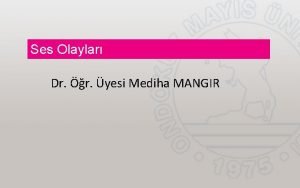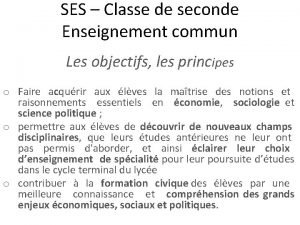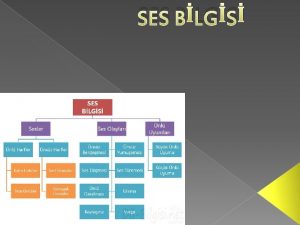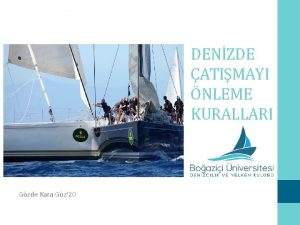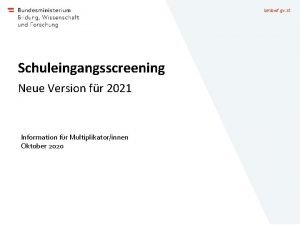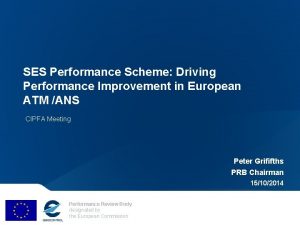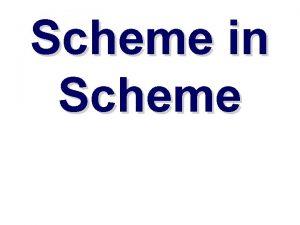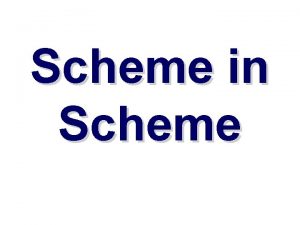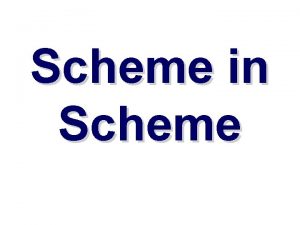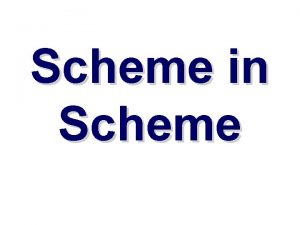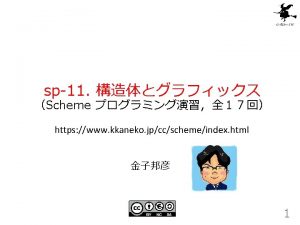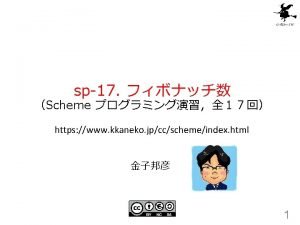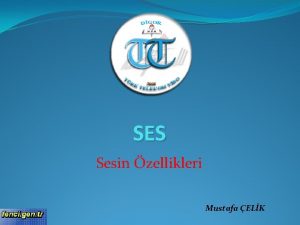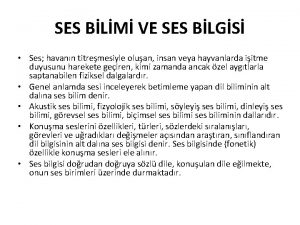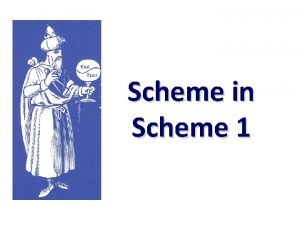SES Performance Scheme Driving Performance Improvement in European





























- Slides: 29

SES Performance Scheme: Driving Performance Improvement in European ATM /ANS CIPFA Meeting Peter Grififths PRB Chairman 15/10/2014 Performance Review Body designated by the European Commission

Content of the presentation • • • The Performance Scheme (PS) The Performance Review Body (PRB) Theory ANS in aviation context Performance Plans US- EU OPS Comparison Future performance improvements Human Factor Conclusions Performance Review Body 2

The Performance Scheme (PS) • One of the key pillars of the SES by setting EU-Wide and Local targets, performance monitoring and corrective actions. • The PS is organised around fixed Reference Periods (RP). RP 1 runs 2012 -2014, RP 2 runs 2015 -2019. • • Targets set are legally binding for EU Member States. The Performance Regulation principles: – 4 Key Performance Areas (KPAs): Safety, Capacity, Environment, Cost Efficiency. – Incentives/cost efficiency linked with Charging Sch. – Staff representation consultation. Performance Review Body 3

The Performance Review Body (PRB) • The PRB Reports to the EC in accordance with provisions of 390/2013 (the Performance Regulation). • The purpose of the PRB is to assist the EC in PS implementation and NSAs on request. • • Competence, impartiality and independency. Main key tasks are: – Advise EC in setting EU-wide performance targets. – Asses National/FAB Performance Plans (and the NM). – Monitor the performance of the system in the 4 KPAs. Performance Review Body 4

ANS in aviation context Safety 6% 6 -12% Punctuality Environment 6% 6% Financial Orders of magnitude for illustrative purposes Orders of magnitude of turnover Performance Review Body 5

Op po rtu nit Reward y Management Balancing Process Decisions Unwanted Event’s s k s Ri Basic Adams Model of Risk For further reading the reference text is: Risk John Adams UCL London 1995 ISBN 1 -85728 -067 -9 HB and 1 -85728 -068 -7 PB Performance Review Body 6

We make decisions on opportunities and risks based on perceptions from our culture. These perceptions apply filters to our model. Performance Review Body 7

The operating loops provide mechanisms which provide systemic management of our companies. The two loops must balance within a risk tolerance boundary. Performance Review Body 8

The two loops must balance within a risk tolerance envelope. Corporate reporting systems ensure we remain within the risk tolerance boundaries. Performance Review Body 9

Performance Review Body 10

At the same time others are making similar decisions all of which impact on others and you. Thus constant review is necessary to ensure that the original decisions are still correct. Performance Review Body 11

Reasons causation (Swiss Cheese) model suggests when these events line up unwanted events occur. Along with the Adams model we can see how this would happen. His investigation into accidents holds true for other company internal or external situations. For further reading the reference text is: Reasons Accident Causation Model, Prof Jim Reason, University of Manchester email: reason@psy. man. ac. uk. Performance Review Body 12

ANS in Aviation context § § § Airborne ANS Flight-efficiency En-route: 1. 0 B TMA, taxi: 1. 2 B ATFM Delays ER: 0. 5, Apt: 0. 3 Total User cost (ground) ATCO 2. 2 B 0. 8 B § 2. 0 B § € 10. 5 B User Charges Support costs Other staff Other operating 3. 5 B € 7. 5 B CAPEX Depreciation Cost of capital Other costs ECTL, MET, NSA All KPAs but Safety expressed in economic terms SES targets address all 3 KPAs (en-route) and Safety Estimated TEC ≈ € 10. 5 B (SES area, 2012) § ANS-related Airborne equipment to be added § TEC fully borne by users of European airspace Performance improvements, more accurate data, different area (SES): lower TEC estimates ATFM delay and flight-efficiency cost estimates must not be interpreted as ANS inefficiency § Trade-offs between KPAs § Optimum is not 0: Minimise TEC within acceptable bounds of safety and security 1. 2 B 0. 8 B Estimated TEC 2012 (SES) Performance Review Body 13

Performance Plans SES targets for all 4 KPAs in RP 2 (En-route) Performance also monitored in TMA Monitoring Performance Review Body 14

Performance Plans § § Reactive policy in the 90’s: delays going up while costs going down, and vice-versa Balanced performance-oriented approach; both delays and unit costs down since 2000 Enforceable SES targets apply from 2012 onwards Fast traffic growth until 2008: challenge for capacity, but helps cost-efficiency § Traffic growth much lower now, even negative: Easier for capacity, harder for cost-efficiency Performance Review Body 15

Performance plans SES States § § § Challenging SES targets for 2012 -2013 were met and even exceeded Best level ever achieved in ATFM delays! Challenging target for 2014 and beyond (0. 5 min/flight), close to optimum Performance Review Body 16

Performance Plans SES area Great Circle broken up using Achieved distance • KEP (FPL) and KEA (actual) vs great circle Excellent routing efficiency of ANS, certainly best of all transport modes (~ 3%) – Yet significant economic impact (fuel burn, flight time) – Impossible to reach 0% with full civil-military traffic load • Improvement in KEA compensates traffic growth (-21% from 2011 to 2019) • • Carbon-neutral growth of aviation (IATA goal due in 2020) already being met by ANS! Network Manager’s flight-efficiency initiative, aimed at reaching SES targets – Role of airlines in closing gap between FPL and actual route (predictability) • Further environmental indicators needed (Vertical, CO 2 efficiency…) – Would require inputs on optimum flight from AOC Performance Review Body 17

Performance Plans Higher DUC starting point (€ 58. 1) than DUR arising from aggregated RP 1 plans (€ 54. 9) in 2014, mainly due to traffic being significantly lower than planned. § § Significant improvement under binding SES cost-efficiency targets Spain played a large role in improvements from 2009 to 2012 Performance Review Body 18

Performance plans ~ 7. 6 B Major savings from RP 1 -2 targets: Some € 7. 6 B vs. 2012 baseline over RP 2 Performance Review Body 19

US-EU OPS comparison Performance Review Body 20

US-EU OPS comparison Performance Review Body 21

US-EU OPS comparison • European unit costs decreased -13% over 2002 -2011 • But still some 50% above US in absolute terms (US 34% below Europe) Performance Review Body 22

US-EU OPS comparison Flight-hours controlled ATCO-hour productivity +55% in US ATCOs in OPS working hours ATCO in OPS cost / ATCO-hour -25% in US Flexibility is key to ATCO productivity Support costs: high share, mostly fixed, opportunity for rationalisation, must be addressed! Performance Review Body ATCOs employment Cost / flight-hour Support costs per flight-hour Unit ATM/CNS provision costs - 48% in US - 25% in US - 34% in US € 85 € 163 € 269 € 348 € 354 € 511 ATCOs in OPS Employment costs + Support costs ATM/CNS provision costs EUROCONTROL/PRU 23

Future performance improvements § Efficiency gains in individual ANSPs § Airspace improvements (e. g. free routes) § More flexible management of capacity to match demand (ATCO contracts) § New Technology § PCP investment mostly on ground, can fit within current CAPEX Main impact expected in TMA, airport traffic § Future deployment must have clear positive CBA, including Airborne ANS part of TEC § Efficient SESAR deployment, e. g. joint procurement, maintenance § Rationalisation of service provision and oversight, including restructuring § Very significant further performance improvements achievable in true Single Sky Performance Review Body 24

Human Factor (Cultural Filters) • • One of SES 5 pillars Staff consultation principle in PR Key to any system drive to change ATCO active involvement key to PS success: – Consultation process – Participation in safety improvement – Introduction of new technology – Process optimisation Performance Review Body 25

Capacity (1/6) – Jan. -Sep. – not P E S N A J • meet o t k c a r t on l the annua target! Performance Review Body 26

Environment – Jan. -Sep. notable s w o h s I P K t in 2014 n e m e v o r imp Performance Review Body 27

Cost-Efficiency – SU’s Jan-AUG. 2013 s v 4 1 0 2 l tua • +4. 2% ac 4 vs. PP 1 0 2 l a u t c • -4, 7% a ow -10% l e b s e t a t • 5 S e +10% v o b a s e t a • 3 St Performance Review Body 28

Conclusions • Significant progress in European ANS performance • Best ever ATFM delays achieved in 2013 • Flight-efficiency target leads to carbon-neutrality of aviation for ANS • Unit costs going down significantly • But margins exist for significant further improvements • European unit costs still nearly 50% above US’s • SES targets for RP 1 -RP 2 bring very significant further improvements • Balance between KPAs is essential • Human factor • Staff is the main asset to drive the change • Win-win opportunity • Change management is key to PS success Performance Review Body 29
 European home improvement monitor
European home improvement monitor The driving force behind european imperialism in africa
The driving force behind european imperialism in africa 3 domain scheme and 5 kingdom scheme
3 domain scheme and 5 kingdom scheme Stata graph schemes
Stata graph schemes Pyramid scheme vs ponzi
Pyramid scheme vs ponzi Ses performance plan examples
Ses performance plan examples Performance improvement plan examples
Performance improvement plan examples Physician consortium for performance improvement
Physician consortium for performance improvement Performance improvement survey
Performance improvement survey Pip template shrm
Pip template shrm Human performance improvement principles
Human performance improvement principles Housekeeping items meeting
Housekeeping items meeting Questioning attitude human performance
Questioning attitude human performance Reflector big five personality oefenen
Reflector big five personality oefenen Call center performance improvement plan template
Call center performance improvement plan template Zoom ses kapatma
Zoom ses kapatma Yardımcı eylem
Yardımcı eylem Ulysse et ses compagnons aveuglant polyphème
Ulysse et ses compagnons aveuglant polyphème önlük artlık uyumu
önlük artlık uyumu Hipersonor
Hipersonor Ekspiryum uzaması
Ekspiryum uzaması Akıcılaşma
Akıcılaşma ıssız kelimesindeki ses olayı
ıssız kelimesindeki ses olayı Ses enseignement commun seconde
Ses enseignement commun seconde Ses bilgisi
Ses bilgisi Un micro ordinateur se caractérise par
Un micro ordinateur se caractérise par Son sa ses mon ma mes
Son sa ses mon ma mes Ses hızı kaç km
Ses hızı kaç km Colreg ses işaretleri
Colreg ses işaretleri Ses schuleingangsscreening
Ses schuleingangsscreening



